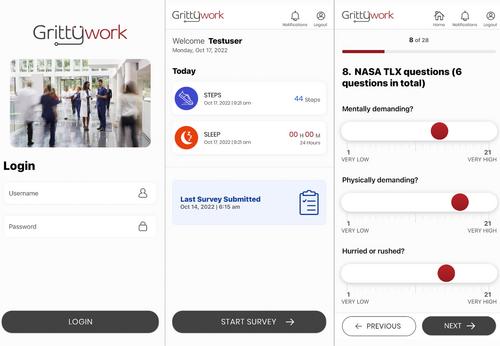The development and pilot of a novel mobile application to assess clinician perception of workload and work environment
Abstract
Background
Traditional measures of workload such as wRVUs may not be adequate to understand the impact of workload on key outcomes.
Objective
The objective of this study was to develop a mobile application to assess, in near real time, clinicians' perception of workload and work environment.
Designs, Settings and Participants
We developed the GrittyWork™ application (GW App) using the Chokshi and Mann process model for user-centered digital development. Study occured at a single academic medical center with hospitalist clinicians.
Main Outcome Measures and Measures
Measures included the System Usability Scale (SUS), use measures from GW App, electronic health record (EHR) event log data and note counts, and qualitative interviews.
Results
From October 28, 2022 to November 3, 2022, six hospitalist clinicians provided feedback on the early prototype of the GW App, and from February 28, 2023 to June 8, 2023, 30 hospitalist clinicians participated in the pilot while on clinical service. All 30 clinicians (100%) participated in the pilot submitting data for a total of 122 shifts. Participants reported working 10 ± 1 h per day (mean ± SD) and were responsible for an average of 11 ± 3 patients per day. The postpilot evaluation of the GW App showed a SUS score of 86 ± 11 and a participant preference toward mobile application-based surveys (73% of participants). Regarding workload measures, EHR event log data and notes data correlated with physician-reported workloads. Applying user-centered design techniques, we successfully developed a mobile application with high usability. These data can be paired with EHR event log data and outcomes to provide insights into the impact of workloads and work environments on outcomes.


 求助内容:
求助内容: 应助结果提醒方式:
应助结果提醒方式:


